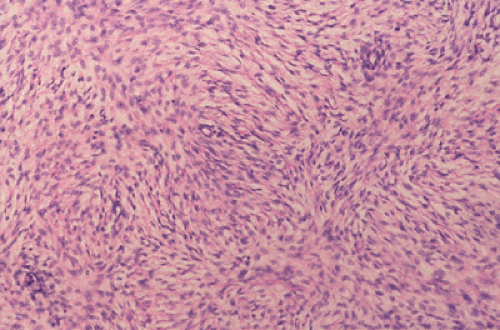Fibrous, Fibrohistiocytic, and Giant Cell Tumor Malignancies
Hannah D. Morgan
Fibrosarcoma, malignant fibrous histiocytoma (MFH) of bone, and malignancy in giant cell tumor (GCT) are three relatively rare bone sarcomas that tend to be of high grade. All are found primarily around the knee. MFH and malignancy in GCT of bone may be primary or secondary malignancies. Malignancy in GCT is the current World Health Organization (WHO) terminology for what has also been referred to as malignant giant cell tumor or dedifferentiated giant cell tumor. MFH is now referred to as pleomorphic sarcoma not otherwise specified (NOS) as it is thought to
represent a final common pathway toward dedifferentiation for many sarcomas.
represent a final common pathway toward dedifferentiation for many sarcomas.
Pathogenesis
Etiology
Fibrosarcoma
Malignant spindle cell tumor with fibroblastic differentiation and a collagenous intercellular background
MFH
Malignant mesenchymal neoplasm of histiocytic origin
72% primary; 28% secondary
Conditions associated with secondary form: bone infarction, fibrous dysplasia, intraosseous lipoma, Paget’s disease, prolonged steroid use, hematopoietic malignancy, history of radiation therapy, and possibly presence of metallic orthopaedic implant (controversial)
Malignancy in GCT
Primary malignancy in GCT: high-grade sarcoma arising beside or within a conventional GCT of bone
Secondary malignancy in GCT: high-grade sarcoma arising at the site of a previously treated conventional GCT (either with surgery alone or with radiation therapy); tumors often multiply recurrent prior to diagnosis of malignancy
Epidemiology
Fibrosarcoma
<5% of malignant bone tumors; may be lower as more cases are diagnosed as fibroblastic osteosarcoma or MFH
Male:female 1:1
Most patients second through seventh decade
Arises in metaphysis, most commonly around the knee
MFH
<2% of malignant bone tumors
Male:female 3:2
All ages affected, but majority >40 years old
75% affect ends of long tubular bones; 50% about the knee
Malignant GCT
Very rare: 1% to 2% of all GCT of bone
Primary malignant GCT: male > female
Secondary malignant GCT: male:female 1:1
Average age: 45 to 50 years
Secondary malignant GCTs
Typically occur >3 years after treatment of original tumor
Average latent period: 9 years
Majority of tumors occur about knee, as for benign GCT of bone.
Pathophysiology
Fibrosarcoma
Uniform fibroblast-like spindle cells arranged in parallel bundles with intercellular collagen in herringbone pattern (Fig 6.4-1)
One study found 22q aberration leading to increased platelet-derived growth factor beta (PDGF-β).
MFH
Plump malignant spindle-shaped cells in sheets and storiform patterns with granular eosinophilic cytoplasm; may have cytoplasmic vacuoles; marked nuclear atypia and numerous atypical mitoses (Fig. 6.4-2)
Stay updated, free articles. Join our Telegram channel

Full access? Get Clinical Tree








